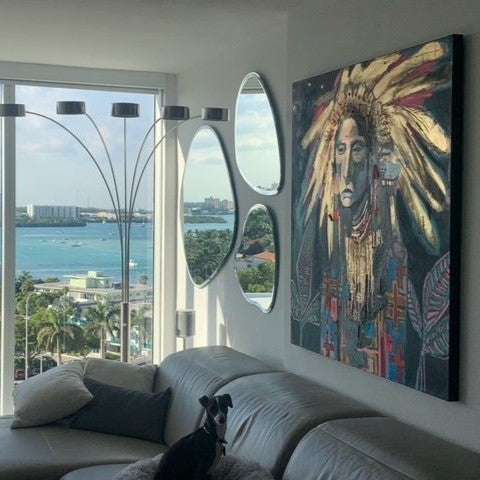What You Should Know About Insuring Your Art



As we've looked at different reasons to consider acquiring the services of a qualified art appraiser, one topic that comes up frequently is the process to acquire insurance for your artwork. While under many circumstances an appraisal is required for insuring fine art, it isn't always clear when a person should insure their collection. Additionally, navigating the process of obtaining art insurance can be a bit intimidating.
For example, many people make the false assumption that their personal art collections and other prized possessions in their home are automatically insured through their homeowners’ insurance policy, but that isn't always the case. Often additional coverage is required to adequately protect your art collection.
If you're in the market for art insurance, we're providing a few tips about navigating the process, and considerations you should keep in mind.
Important Disclaimer: We aren’t experts in insurance or the appraisal of art and you should consult a tax professional, certified art appraiser, or your insurance authority depending on the specific nature of the advice you seek relating to art insurance and appraisals. We’ll provide some valuable links and resources as we go.
What is (and More Importantly What's Not) Covered by Homeowners Insurance
Having a general impression about the value of your art will be the first step in determining if your current coverage is sufficient or if you need additional coverage. For art that carries a significant value, you should give serious consideration to additional coverage. While as a general rule homeowners’ insurance may not cover fine art and collectibles depending on the circumstances, gather the facts and talk to your agent before taking further action. Review your homeowners’ policy carefully and if you're still not sure what is covered, ask your insurance company lots of questions about your current coverage limits. Examples of useful questions for insurance providers may include:
Review your homeowners’ policy carefully and if you're still not sure what is covered, ask your insurance company lots of questions about your current coverage limits. Examples of useful questions for insurance providers may include:
- Does my existing policy cover fine art? What if anything is specifically excluded?
- If I am covered, what types of events qualify (natural disaster, accidental damage, house fire)?
- If I experience a loss, am I covered under my policy for replacement value or actual cash value?
- What are the coverage limits in case of theft or mysterious disappearance?
- What valuation method is used for settling claims?
- Should I consider a separate scheduled personal property policy?
If Your Current Policies Aren't Sufficient, Use Care to Pick the Right Policy
Insuring art may require speaking with an art insurance specialist. A serious art collector would be wise to seek a fine art insurance policy and agency that deals specifically with fine art loss. For example, if you have multiple artworks worth $10,000 each, it is worth your time to inquire with an insurance broker that specializes in fine art insurance.
These specialists are adept at understanding the unique characteristics and recognizing the difference between a basic print and an original work, among other valuable qualifications. You should plan to ask the specialist many of the same questions we posed with regard to a basic homeowners policy, as well as how fine art policies address agreed value and current market value. Like many other types of assets, this requires that you are maintaining an updated appraisal of your collection. Experts recommend having your appraisals updated every two to three years.
Art Appraisals for Insurance Purposes
When hiring an art appraiser, some things are non-negotiables. According to Santa Fe art appraiser Jennifer Lynch: "Quality. You should expect that the appraiser does their due diligence and that they personally inspect the artwork."
There are several things to keep in mind when seeking an art appraisal for insurance purposes:
- Ask the appraiser about their credentials to ensure they are a qualified professional. You should hire an appraiser that is associated with a credible association such as the American Society of Appraisers or the International Society of Appraisers.
- While there may be rare circumstances in which an appraisal can't be done in person, if at all possible your appraiser should review and closely examine your art first-hand.
- You should provide your appraiser with as much documentation as possible (receipts, invoices, evidence of provenance, and images).
For more information on working with an appraiser, check out our recent interview with Jennifer Lynch, an expert in the field.
What to Expect if You Have to File a Claim
Though we hope they never impact our own families, natural disasters are some of the more common reasons homeowners and art collectors make claims. In 2012, Hurricane Sandy caused damages to both personal and commercial collections to the tune of about half a billion dollars. Insurance experts indicate that damage during transportation is also a common event that results in a claim. While theft is lower on the list of reasons for filing a claim, this is also not completely outside the realm of possibility. With this in mind, what should you expect if you have to file a claim?
- With the potential of a natural event or other incidents in mind, make sure you maintain updated records of each piece and keep a full inventory in an easy-to-access location.
- After collecting all the relevant information associated with your art collection, reach out to the claims department within the insurance organization in order to file your claim.
- A claims adjuster will typically set up an appointment to assess the damage.
- If the art can be repaired, expect that you will likely be reimbursed for the cost of repairs, while if the item is lost or stolen, anticipate receiving replacement cost as outlined in your plan.
In addition to its market value, art is irreplaceable because of the personal connection and sentimental value of these works. Nonetheless, you can gain some peace of mind knowing you’ve acquired greater protection for your beloved artworks.
For those of you who enjoy collecting art, we hope this unofficial guide to insurance has been helpful in determining how to go about protecting your assets. Considering adding more to your collection? You can view original art on our website including new art added weekly.





